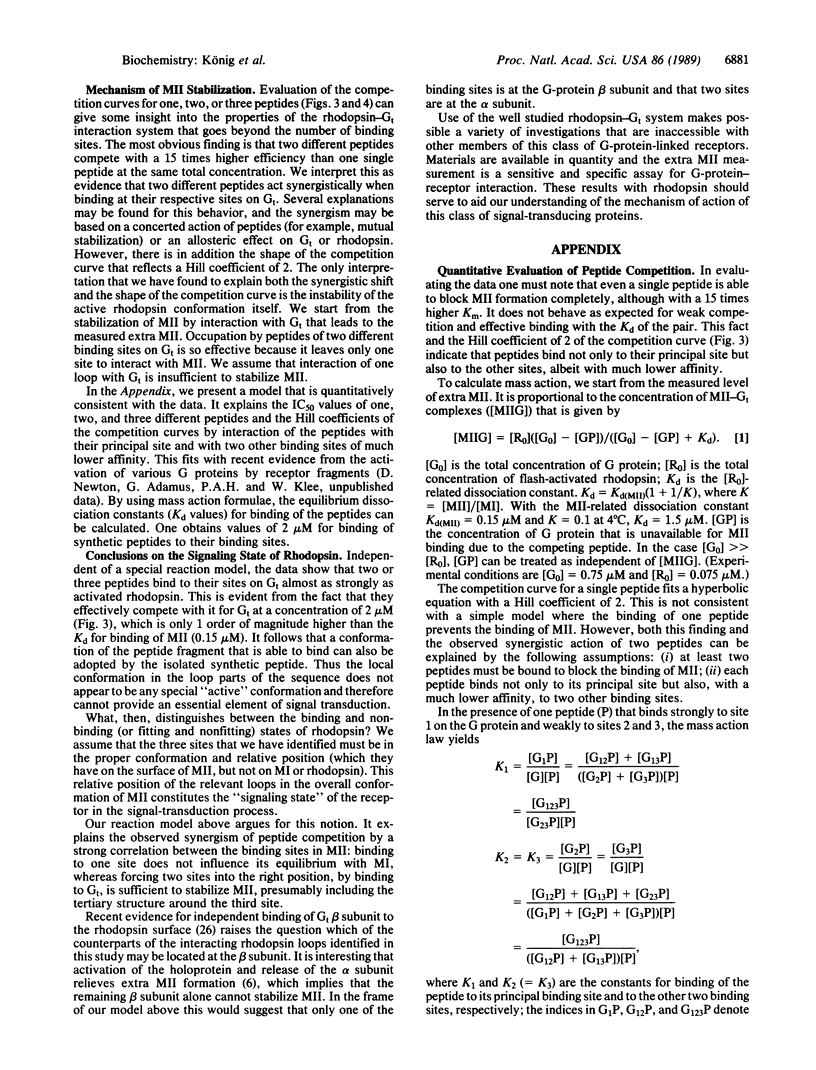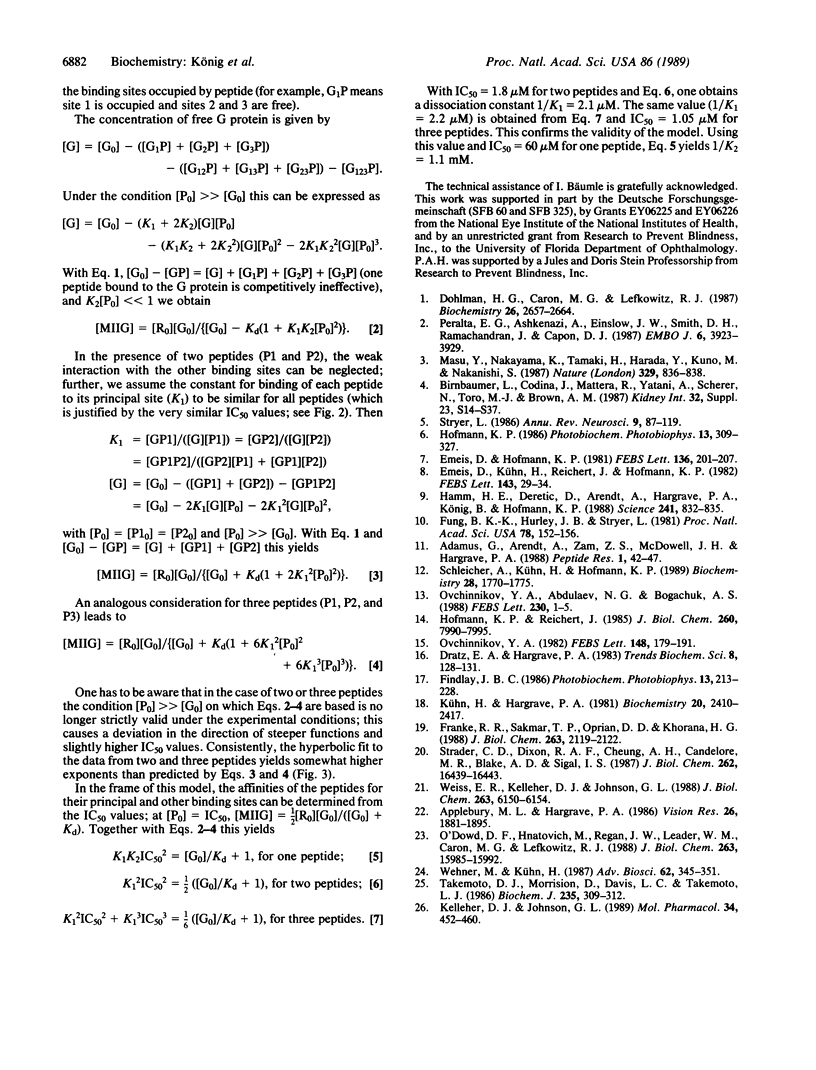Abstract
Rhodopsin is a member of an ancient class of receptors that transduce signals through their interaction with guanine nucleotide-binding proteins (G proteins). We have mapped the sites of interaction of rhodopsin with its G protein, which by analogy suggests how other members of this class of receptors may interact with their G proteins. Three regions of rhodopsin's cytoplasmic surface interact with the rod cell G protein transducin (Gt). These are (i) the second cytoplasmic loop, which connects rhodopsin helices III and IV, (ii) the third cytoplasmic loop, which connects rhodopsin helices V and VI, and (iii) a putative fourth cytoplasmic loop formed by amino acids 310-321, as the carboxyl-terminal sequence emerges from helix VII and anchors to the lipid bilayer via palmitoylcysteines 322 and 323. Evidence for these regions of interaction of rhodopsin and Gt comes from the ability of synthetic peptides comprising these regions to compete with metarhodopsin II for binding to Gt. A spectroscopic assay that measures the "extra MII" caused by Gt binding was used to measure the extent of binding of Gt in the presence of competing peptides. The three peptides corresponding to the second, third, and fourth cytoplasmic loops competed effectively with metarhodopsin II, exhibiting Kd values in the 2 microM range; 11 additional peptides comprising all remaining surface regions of rhodopsin failed to compete even at 200 microM. Any two peptides that were effective competitors showed a synergistic effect, having 15 times higher effectiveness when mixed than when assayed separately. A mathematical model was developed to describe this behavior.
Full text
PDF




Images in this article
Selected References
These references are in PubMed. This may not be the complete list of references from this article.
- Adamus G., Arendt A., Zam Z. S., McDowell J. H., Hargrave P. A. Use of peptides to select for anti-rhodopsin antibodies with desired amino acid sequence specificities. Pept Res. 1988 Sep-Oct;1(1):42–47. [PubMed] [Google Scholar]
- Applebury M. L., Hargrave P. A. Molecular biology of the visual pigments. Vision Res. 1986;26(12):1881–1895. doi: 10.1016/0042-6989(86)90115-x. [DOI] [PubMed] [Google Scholar]
- Dohlman H. G., Caron M. G., Lefkowitz R. J. A family of receptors coupled to guanine nucleotide regulatory proteins. Biochemistry. 1987 May 19;26(10):2657–2664. doi: 10.1021/bi00384a001. [DOI] [PubMed] [Google Scholar]
- Emeis D., Hofmann K. P. Shift in the relation between flash-induced metarhodopsin I and metarhodpsin II within the first 10% rhodopsin bleaching in bovine disc membranes. FEBS Lett. 1981 Dec 28;136(2):201–207. doi: 10.1016/0014-5793(81)80618-7. [DOI] [PubMed] [Google Scholar]
- Emeis D., Kühn H., Reichert J., Hofmann K. P. Complex formation between metarhodopsin II and GTP-binding protein in bovine photoreceptor membranes leads to a shift of the photoproduct equilibrium. FEBS Lett. 1982 Jun 21;143(1):29–34. doi: 10.1016/0014-5793(82)80266-4. [DOI] [PubMed] [Google Scholar]
- Franke R. R., Sakmar T. P., Oprian D. D., Khorana H. G. A single amino acid substitution in rhodopsin (lysine 248----leucine) prevents activation of transducin. J Biol Chem. 1988 Feb 15;263(5):2119–2122. [PubMed] [Google Scholar]
- Fung B. K., Hurley J. B., Stryer L. Flow of information in the light-triggered cyclic nucleotide cascade of vision. Proc Natl Acad Sci U S A. 1981 Jan;78(1):152–156. doi: 10.1073/pnas.78.1.152. [DOI] [PMC free article] [PubMed] [Google Scholar]
- Hamm H. E., Deretic D., Arendt A., Hargrave P. A., Koenig B., Hofmann K. P. Site of G protein binding to rhodopsin mapped with synthetic peptides from the alpha subunit. Science. 1988 Aug 12;241(4867):832–835. doi: 10.1126/science.3136547. [DOI] [PubMed] [Google Scholar]
- Hofmann K. P., Reichert J. Chemical probing of the light-induced interaction between rhodopsin and G-protein. Near-infrared light-scattering and sulfhydryl modifications. J Biol Chem. 1985 Jul 5;260(13):7990–7995. [PubMed] [Google Scholar]
- Kelleher D. J., Johnson G. L. Transducin inhibition of light-dependent rhodopsin phosphorylation: evidence for beta gamma subunit interaction with rhodopsin. Mol Pharmacol. 1988 Oct;34(4):452–460. [PubMed] [Google Scholar]
- Kühn H., Hargrave P. A. Light-induced binding of guanosinetriphosphatase to bovine photoreceptor membranes: effect of limited proteolysis of the membranes. Biochemistry. 1981 Apr 28;20(9):2410–2417. doi: 10.1021/bi00512a007. [DOI] [PubMed] [Google Scholar]
- Masu Y., Nakayama K., Tamaki H., Harada Y., Kuno M., Nakanishi S. cDNA cloning of bovine substance-K receptor through oocyte expression system. 1987 Oct 29-Nov 4Nature. 329(6142):836–838. doi: 10.1038/329836a0. [DOI] [PubMed] [Google Scholar]
- O'Dowd B. F., Hnatowich M., Regan J. W., Leader W. M., Caron M. G., Lefkowitz R. J. Site-directed mutagenesis of the cytoplasmic domains of the human beta 2-adrenergic receptor. Localization of regions involved in G protein-receptor coupling. J Biol Chem. 1988 Nov 5;263(31):15985–15992. [PubMed] [Google Scholar]
- Ovchinnikov YuA, Abdulaev N. G., Bogachuk A. S. Two adjacent cysteine residues in the C-terminal cytoplasmic fragment of bovine rhodopsin are palmitylated. FEBS Lett. 1988 Mar 28;230(1-2):1–5. doi: 10.1016/0014-5793(88)80628-8. [DOI] [PubMed] [Google Scholar]
- Ovchinnikov YuA Rhodopsin and bacteriorhodopsin: structure-function relationships. FEBS Lett. 1982 Nov 8;148(2):179–191. doi: 10.1016/0014-5793(82)80805-3. [DOI] [PubMed] [Google Scholar]
- Peralta E. G., Ashkenazi A., Winslow J. W., Smith D. H., Ramachandran J., Capon D. J. Distinct primary structures, ligand-binding properties and tissue-specific expression of four human muscarinic acetylcholine receptors. EMBO J. 1987 Dec 20;6(13):3923–3929. doi: 10.1002/j.1460-2075.1987.tb02733.x. [DOI] [PMC free article] [PubMed] [Google Scholar]
- Schleicher A., Kühn H., Hofmann K. P. Kinetics, binding constant, and activation energy of the 48-kDa protein-rhodopsin complex by extra-metarhodopsin II. Biochemistry. 1989 Feb 21;28(4):1770–1775. doi: 10.1021/bi00430a052. [DOI] [PubMed] [Google Scholar]
- Strader C. D., Dixon R. A., Cheung A. H., Candelore M. R., Blake A. D., Sigal I. S. Mutations that uncouple the beta-adrenergic receptor from Gs and increase agonist affinity. J Biol Chem. 1987 Dec 5;262(34):16439–16443. [PubMed] [Google Scholar]
- Stryer L. Cyclic GMP cascade of vision. Annu Rev Neurosci. 1986;9:87–119. doi: 10.1146/annurev.ne.09.030186.000511. [DOI] [PubMed] [Google Scholar]
- Takemoto D. J., Morrison D., Davis L. C., Takemoto L. J. C-terminal peptides of rhodopsin. Determination of the optimum sequence for recognition of retinal transducin. Biochem J. 1986 Apr 1;235(1):309–312. doi: 10.1042/bj2350309. [DOI] [PMC free article] [PubMed] [Google Scholar]
- Weiss E. R., Kelleher D. J., Johnson G. L. Mapping sites of interaction between rhodopsin and transducin using rhodopsin antipeptide antibodies. J Biol Chem. 1988 May 5;263(13):6150–6154. [PubMed] [Google Scholar]



